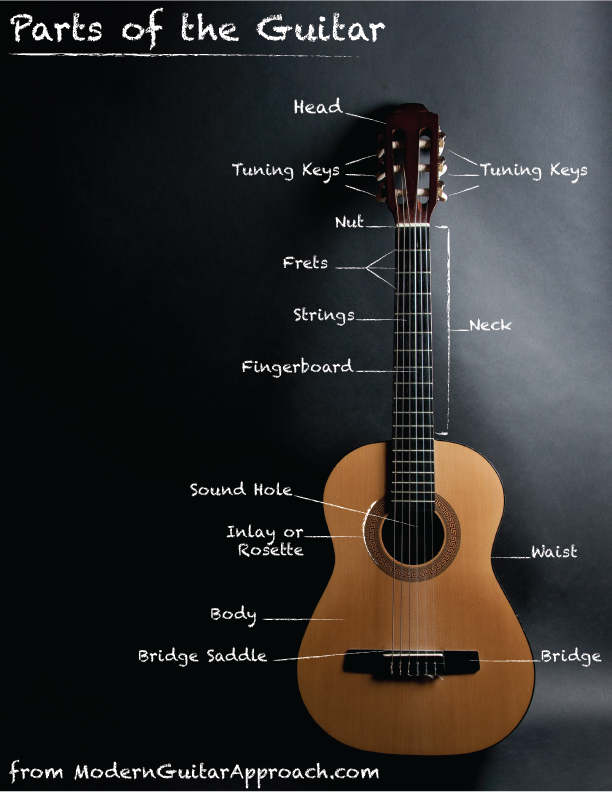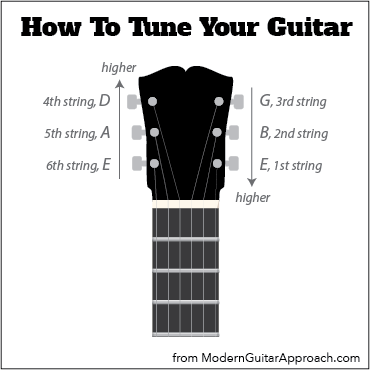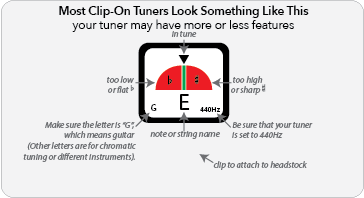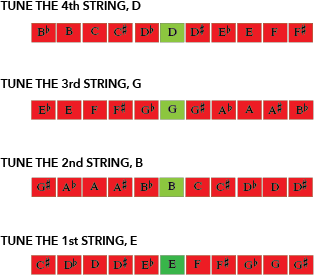Before you can begin to play song, you need to tune your guitar. This post will help someone who has never played before learn how to tune their guitar by using a tuner.

Parts of the Guitar
Since this lesson is for a total beginner, I’m going to back up a couple of steps. When I’m teaching a student for the first time, I find that it is helpful to teach the parts of the guitar before tuning. Below is a photo of the guitar parts on an acoustic guitar.

How to hold the Guitar
There are many ways to hold a guitar. Even with those differences, here are some important things to keep in mind when holding the guitar.
- The waist of the guitar rests over the right leg
- The neck of the guitar extends to the left
- The neck of the guitar should also be slightly upward and higher than the body of the guitar.
- Your left elbow shouldn’t be resting on your leg, instead it should be in the air.
- Both feet should be on the ground unless you have a footstool (not like the picture)
- The right arm rests on the top of the guitar and you strum over or just behind the sound hole.

A footstool can also help keep the guitar close to your body which helps you hold your guitar correctly.
How To Tune Your Guitar
1. IDENTIFY THE TUNING KEYS
Follow each string up to its tuning key on the head of the guitar.
2. TRY ADJUSTING THE PITCH
Tightening the string raises the pitch, while loosening it makes the pitch lower. The direction you rotate the tuning key depends on the type of guitar you have. As a general rule, strings 6, 5, & 4 become higher sounding as you turn the key away from you. Strings 1, 2 & 3 become higher sounding as you turn the key towards you.
3. KNOW THE NOTES EACH STRING SHOULD PLAY
The names of the strings, starting with sting six are: E, A, D, G, B, E. The sentence Easter Angels Don’t Give Broken Eggs can help you remember these notes.

5. GET TO KNOW YOUR TUNER
If you have a clip-on tuner, connect it to the headstock of your guitar and turn it on. If your tuner is a phone app or uses a microphone, make sure it is near the sound hole. Double check that your tuner says 440Hz (if this is an option on your tuner). If your tuner can be used to tune other instruments, set your tuner for guitar (G).

When tuning, be sure to pluck the string that you’re tuning often with your right hand. Also, turning the tuning keys slowly and a little at a time will make tuning easier.
TUNE THE 6th (LOWEST) STRING, E
Pluck the 6th string with your right hand while slowly turning the tuning key with your left hand. Look for the note name E. Below is a chart to help make sure that before you start tuning for E, that you are on the right note!

Next, tune the 5th string. The chart below gives you the same guidance to make sure that you really are tuning for the 5th string.

Repeat the same process with the remaining strings. Keep in mind that your guitar tuning keys might tune in a different direction with strings 1, 2 & 3.

